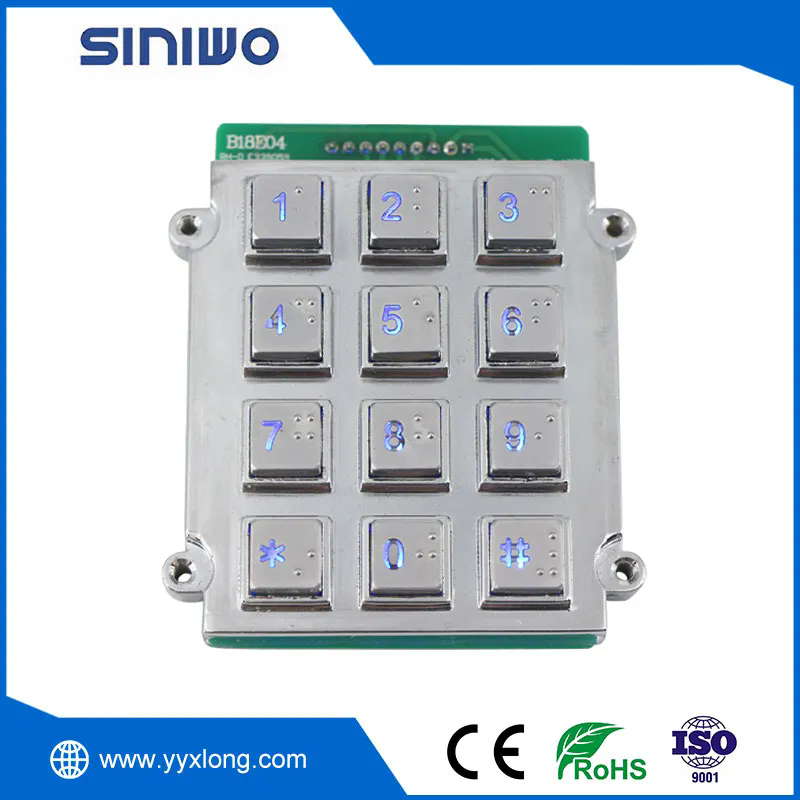Why Is the Industrial Braille Keypad Essential for Accessibility in Modern Technology?
2024-11-07
In a world that is rapidly advancing in technology, accessibility for individuals with visual impairments is more important than ever. One of the key innovations helping bridge this gap is the industrial Braille keypad. But why exactly is this device so essential in modern industries, and how does it contribute to creating a more inclusive environment for all?
In this blog, we’ll explore the importance of industrial Braille keypads, the features that make them effective, and how they help ensure that technology remains accessible to everyone, regardless of their visual abilities.
What Is an Industrial Braille Keypad?
An industrial Braille keypad is a specialized input device designed to allow visually impaired individuals to interact with machines and systems that typically rely on visual interfaces, such as control panels, machinery, and automated systems. It incorporates Braille—a tactile writing system used by blind or visually impaired people—into its design. The keys are raised in a specific pattern, allowing users to feel and identify the characters, numbers, or functions assigned to each key.
These keypads are commonly found in industries such as manufacturing, transportation, healthcare, and telecommunications, where operators or workers may need to interact with equipment but require an accessible method to do so.
Why Is Accessibility Important in Industrial Settings?
Accessibility is not just a matter of inclusivity; it’s also about safety, efficiency, and legality. In industries where machinery is operated or monitored by personnel, having access to control systems through tactile interfaces like Braille keypads ensures that everyone, including those with visual impairments, can work independently and effectively.
In many countries, accessibility regulations and standards require businesses to provide accommodations to employees with disabilities. The Americans with Disabilities Act (ADA) in the United States and other similar regulations globally enforce the need for workplaces to be accessible. By integrating Braille keypads into industrial systems, businesses comply with these standards, fostering a more inclusive environment.
How Do Industrial Braille Keypads Improve Workplace Efficiency?
Aside from making systems accessible, industrial Braille keypads can improve workplace efficiency in several ways:
1. Reduced Training Time: Workers who are visually impaired can quickly learn to navigate equipment and systems without relying on sight, which reduces the time spent on training. The tactile nature of the keypad enables them to independently operate the machinery from the start.
2. Increased Safety: In high-stakes industries like manufacturing or healthcare, safety is paramount. A Braille keypad allows visually impaired workers to confidently control machines, reducing the risk of accidents caused by misinterpretation of visual data or reliance on others for assistance.
3. Independence and Empowerment: One of the biggest advantages of industrial Braille keypads is that they allow visually impaired individuals to work independently. By using a tactile system, employees can operate equipment without needing constant supervision or assistance, which boosts their confidence and morale.
How Do Industrial Braille Keypads Differ from Standard Keypads?
While traditional keypads rely on visual feedback, Braille keypads are designed to be intuitive for those who cannot see. Here are a few features that set Braille keypads apart:
- Tactile Buttons: Each button on the keypad is raised, allowing users to feel the Braille characters corresponding to numbers, letters, or symbols. These keypads may also have additional symbols or indicators that assist in identifying different functions.
- Customization for Specific Applications: Depending on the industrial setting, Braille keypads can be customized to include specific symbols or functions necessary for that particular environment. For example, medical equipment may require a Braille keypad with specific medical symbols, while manufacturing machinery might include Braille labels for operational controls.
- Durability and Resistance: Since these keypads are used in industrial environments, they are built to withstand harsh conditions. They are typically made from durable materials that can resist oil, dust, and extreme temperatures, ensuring that the keypad remains functional over time.
- Non-visual Feedback: In addition to tactile feedback, some Braille keypads may include audible cues to confirm input, providing further accessibility for users.
How Do Industrial Braille Keypads Benefit Other Users?
While these keypads are primarily designed for individuals with visual impairments, their design and functionality can also be beneficial to other users. For example:
- Multitasking Workers: In noisy or high-stress environments, workers might find it difficult to rely solely on visual interfaces. Braille keypads, with their tactile feedback, allow for more effective multitasking without having to look at a screen.
- Efficiency in Low-Light Conditions: In environments where lighting is poor or inconsistent, workers can use the Braille keypad to navigate systems without the need for constant visual reference.
- Training Aid for New Users: New workers, regardless of their vision abilities, can use the Braille keypad as an intuitive and consistent way to interact with industrial machinery or systems, ensuring a smoother learning curve.
Conclusion: How Does the Industrial Braille Keypad Contribute to an Inclusive Future?
Incorporating industrial Braille keypads into technology and machinery is a critical step toward achieving greater accessibility and inclusivity. These devices not only ensure that individuals with visual impairments have equal access to career opportunities but also improve safety, productivity, and independence in the workplace.
As industries continue to evolve, embracing accessible technology will become increasingly essential. The industrial Braille keypad represents a small but powerful change that can make a significant impact on the lives of many, ensuring that the future of work is open to everyone, regardless of their physical abilities.
So, why is the industrial Braille keypad essential for accessibility? Because it empowers individuals, ensures equal opportunity, and paves the way for a more inclusive, accessible future in the workplace.



